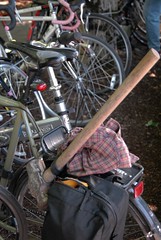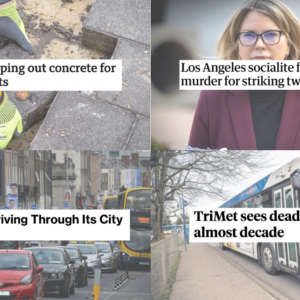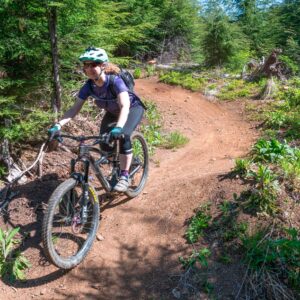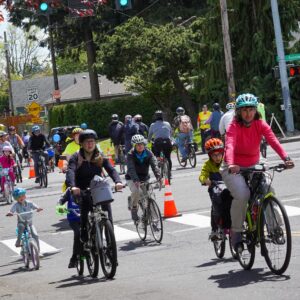With car use in decline across the country, millions of urban acreage currently devoted to parking them will soon go fallow.
What to do with all those parking lots? Depave them!
The International Towards Carfree Cities conference kicked off this morning with a depaving event in North Portland.
Scores of volunteers from Portland-based Depave pounded, cracked-up, and then carried away tons of pavement from the parking lot at the SE corner of N. Fargo and Williams.
Soon to be put in its place will be expanded bike parking for nearby businesses and an urban forest and community space.
I spoke to the owner of the parking lot, Angela Goldsmith. She said she offered up her lot — instead of building a triplex — because, “this is more inspiring”. Goldsmith made today’s event a family affair with her children and her mom all taking part.
Paul Tay, who’s visiting from Tulsa Oklahoma to take part in Pedalpalooza and the Carfree Conference, said today’s event is symbolic. “Machines put this lot together, now we’re using human power to reclaim the space. There’s a lot of symbolism here.”
The Carfree Cities Conference runs from today through Friday (6/20). Tomorrow is the free public day and opening of the Carfree Art Show at City Hall. For more information on the steller program of events and panels visit CarfreePortland.org.
Check out the latest photos from Depaving Day and all the Carfree Conference events.








Thanks for reading.
BikePortland has served this community with independent community journalism since 2005. We rely on subscriptions from readers like you to survive. Your financial support is vital in keeping this valuable resource alive and well.
Please subscribe today to strengthen and expand our work.
Depaving can \”pave\” the way to saner sustainable lifestyles, a cleaner environment, and an eventual end to the growing global food crisis. Kudos to Angela Goldsmith.
More trees! Good. Tons of pavement – that\’s a lot of bike trips! (just kidding). Wonderful to see, and hard to believe the lot owner has her heart so firmly in the right place.
thanks to ALL of the volunteers. we even had conference registrants and media lending a hand in this incredible event (hauling, setting up, taking down). way to kick of an awesome week, everyone.
it was a pleasure having you join us for the work party at the waypost, jonathan.
one quick note–the conference ends on the20th, not the 21st. however, there\’s the sunday parkways event on sunday the 22nd. not to be missed.
m.
Thanks *everyone* who came out for a really fun work party.
Hope to see a lot of you again in PSU\’s Smith Center tomorrow for our public day — or for the art show at City Hall in the evening — or at our movie night Wednesday, or the Square Dance in Old Town Chinatown Thursday.
carfreeportland.org/program for the full lineup.
This week is off to a pretty amazing start.
Bummed I couldn\’t make it to this event. I really like the idea of cracking up some asphalt.
Three cheers (and three trees) for Angela Goldsmith!
simply. awesome.
Awesome, simply awesome.
This is really cool. I\’m love the addition of a garden to the community. However, I do want to play \”Devil\’s advocate\” for a second. I\’m guessing the depaving movement is generally motived by some concern for sustainability. So, let\’s ask ourselves if this use of the lot is the best for advancing the cause of sustainability. At first glance it may seem like it is, but I could see how some might argue otherwise. For example, three housing units could have been built on the site. That\’s 3 more families that could live in a location along a bike route, close to the city that will now have to find another place to live. Suppose those 3 familis find another place on N. Interstate, but they get their appartment because the previous renter is run out by high rent. Now where does that renter go? Perhaps he goes to Gresham, and what happens in Gresham? The suburb of Gresham has to keep sprawling in order to accomodate all the people that have to move to cheaper housing, thus encouraging the paving of forest and farmland to accomodate those 3 familis that could be housed on Williams & Fargo.
So, let me summarize the concern: By depaving in the urban core of Portland, we might actually be encouraging even more paving outside of Portland through a cause-and-effect chain reaction. Perhaps the best way to fight the paving of America is to densify our urban centers as much as possible in order to alleviate demand for suburban sprawl. This depaving event may have had its heart in the right place, but it still may have been one step forward and two steps back.
Let me reiterate that it will bring a smile to my face everytime I see that garden on Williams Ave. It\’s a wonderful thing. But let\’s entertain the dialogue about whether or not this is really the best option for the greater cause of sustainability.
this parking lot was unused, and the other three corners are either vacant or paved. why not create a livable outdoor space for people who already live in the existing housing units there.
RE: Devils Advocate
I think that\’s a fair point. Brownfield land is valuable, and can support sustainable housing.
However, in order to make a city sustainable AND livable, urban parks & greenspace are also very important component.
In many countries in Europe, one of the criteria used to measure how \”successful\” a city is, is what percentage of people live within a short walking distance (typically 300 metres) of a greenspace that is X square feet or larger in size.
Europe has really caught on to the fact that parks and other urban greenspaces really are the \”green lungs\” of a city, and are as much a requirement as housing and other developments. Parks and other public greenspaces are paticularly important in the new urban city, given that a lot of newer inner-city redevelopments are condos or highrises that do not necessarily include gardens for residents.
It\’s all about balance, and with all of the new development and redevelopment happening in Portland, I think it\’s important not to leave greenspace out of the mix. Just my two little cents!
What an amazing event! Congratulations!
Can you imagine what an amazing amount of work we\’ll have Depaving all of the parking lots in front of PetCo, BestBuy, and Linens N Things when those chains go under? We\’ll need to think of some good ways to reuse all of that asphalt and concrete, aka Urbanite. Thankfully, it makes a good plinth for cob garden sheds.
-Ian
Okay. I\’ll bite. This isn\’t about a linear think. It\’s all about choice. As a property owner I have chosen to produce a \”sustainable\” edible forest garden that is a neighborhood resource. Other properties in this neighborhood are slated to be more businesses and living space on top, creating much more housing than my 2,500 sq ft lot ever could. It will be their responsibility to make sure that their housing is mixed affordability and we in the neighborhood can push for that.
IF, I was to build there I would have to raise the low rents I offer my current adjacent tenants. Their low rents create a cycle I\’m loving. They love their places and take care of them. I\’m, in turn inspired to create more livability bonuses. This is long-term vision. I am not an absentee landlord. If these tenants are not my friends, we are at least a community in which we respect each other and do our part. So is the 2,500 sq ft. forest long term vision, the idea of a 50 year old cherry tree gracing that little corner of park space.
\”I\” will not be able to change the attraction of fast, high profit from the buy, build & sell mindset that most fall into these days.
This is not a full-on synopsis of the process I went through to come to my decision. The building material costs, contractor, asbestos abatement costs that the developer up the street just put out and now has to sit on…these are all market considerations. China and Mexico paving away in an all out for profit descent into pavement hell….
I\’m not in this business. And, I encourage other people in my position to maintain that balance of which \”K\” wrote. There will always be builders & gardeners. I\’m a gardener and the people that live and come to live in this neck of the wood will be able to sip a cup on the patio and meander through a miniature forest, pick a plum, a berry, chat with neighbors and enjoy that little corner of nature.
The urban growth boundary is another conversation.
Devil\’s Advocate.
You raise an argument which dominated the early days of land-use planning in Oregon. The old view is that UGBs were about urban containment in order to protect nature “out there”, beyond the Urban Growth Boundary—at the coast, in the Cascades or up the Columbia River Gorge.
There are a couple problems with this approach and the premise behind it. First nature isn\’t just \”out there\”… we actually live in a resilient urban ecosystem that is ecologically viable in supporting things like wildlife and water quality as well as public health and safety. For this reason, our success in avoiding sprawl in the Willamette Valley will require making cities safer, more livable for everyone so that people are not compelled (politically and/or economically) to keep running away from cities devoid of nature. In other words density without good ecological design in proximity to ecologically viable greenspace is not a sustainable strategy of urbanization… because people need and want nature where they live, work, and play.
So protection and recovery of greenspace of all sizes and functions inside the UGB is actually integral to the regional growth strategy meant to use land more efficiently by maintaining nature nearby. Combined with smart transportation investments and walkable neighborhoods, this is actually our best chance to minimize urban land consumption.
Angela\’s willingness to have her space to greenspace is particularly welcome because this portion of North Portland is particularly deficient of greenspace… especially with natural features… and will undoubtedly be growing more dense. As transportation and energy cost rise and the market for dense living continues to return… urban greenspaces will be all the more critical our quality of life.
Jim Labbe